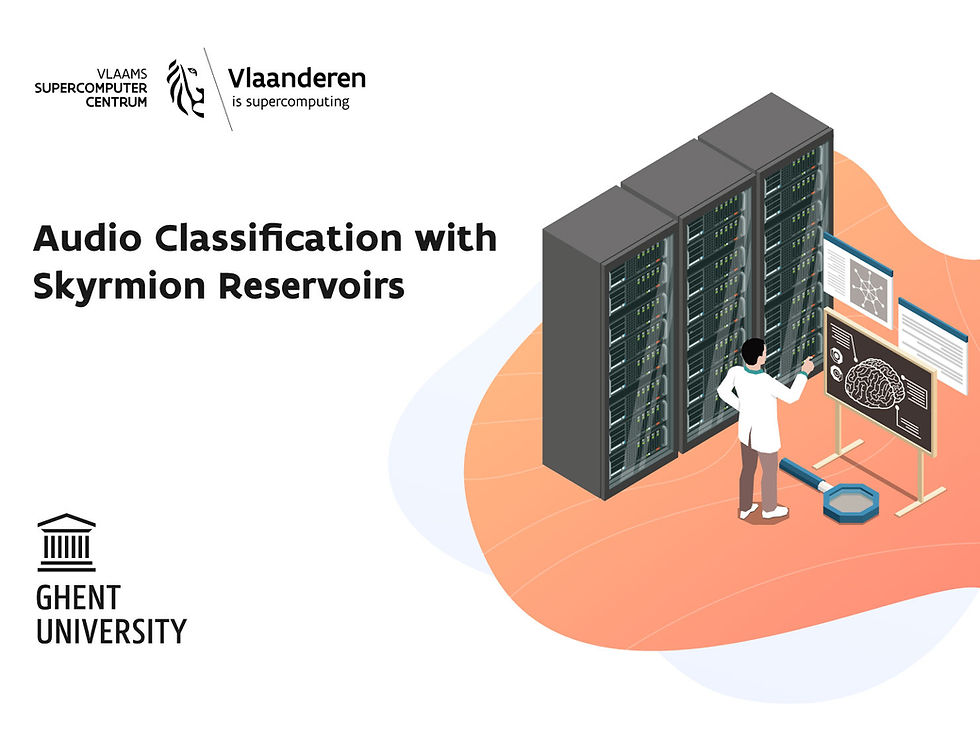Audio Classification with Skyrmion Reservoirs
- Rafal Tekreeti

- Apr 24, 2023
- 3 min read


Physical reservoir computing is a computational paradigm that enables spatiotemporal pattern recognition to be performed directly in matter. The use of physical matter leads the way toward energy-efficient devices capable of solving machine learning problems without having to build a system of millions of interconnected neurons. In a recent Advanced Intelligent systems paper, researchers from Ghent University and the University of Duisburg-Essen (Germany) presented a high-performance skyrmion reservoir that implements the reservoir computing model with multidimensional inputs. This implementation solves spoken digit classification tasks with an overall model accuracy of 97.4% and a < 1% word error rate - the best performance ever reported for in materio reservoir computers.
How does a skyrmion reservoir computer work?
Physical reservoir computers consist of two main components, a nonlinear substrate, known as “the reservoir,” and a trainable linear readout layer. Temporal inputs are fed into the substrate in the form of physical perturbations, exciting the state of the reservoir. By observing a high-dimensional finite representation of the substrate, it is possible to construct a mapping from the original temporal input to a high-dimensional latent space in which input features can be classified linearly. For an ideal reservoir, one can use the results of previously encountered mappings to train the readout layer to recognize patterns in individual input signals via a linear model.
Concretely, this study used audio recordings of the spoken digits ranging from 0 to 9 from a standard database. The type and intensity of the frequencies involved for each moment of the spoken word were converted into voltage signals, which were applied to a thin magnetic film via 39 contacts.

As shown in Figure 2, this thin film material contains small magnetic whirls (skyrmions) that react to the voltage by deforming. To put it simply, you can imagine it as a black-and-white grid pattern that changes shape in response to input signals. The material thus forms unique patterns for each spoken number – like a QR code – which can be read out linearly with simple methods.
The long-range coupling makes the numerical integration of these equation very challenging, and the large amount of simulations required for this project would not have been possible without the HPC infrastructure of the Flemish Supercomputer Center.
Modeling the Magnetization dynamics
As a part of their research, the team from the DyNaMat research group used micromagnetic simulations. The magnetization dynamics on the nanoscale are described by a set of nonlinear partial differential equations which are all coupled together via both short range (magnetic exchange) and long-range (magnetostatic) interactions. Especially the long-range coupling makes the numerical integration of these equation very challenging, and the large amount of simulations required for this project would not have been possible without the HPC infrastructure of the Flemish Supercomputer Center. The GPU-accelerated mumax3 software which is used for the micromagnetic simulations was developed at Ghent University and runs at maximum performance on the Hortense supercomputer which contains 80 GPU’s.
Due to the quality of the results and the low-power properties of magnetic texture reservoirs, it is evident that skyrmion fabrics are a compelling candidate for reservoir computing.
The material system correctly recognized 97.4 percent of the numbers. Examining only female voices, the figure rose to 98.5 percent, which is the best performance ever reported for in-material reservoir computers. "If one uses a neural network, training is expensive and requires enormous data sets. Our material system can solve machine learning problems without building a system of millions of interconnected neurons – the speech recognition shown here is just one example. It's faster and uses less energy".
Several other potential applications can be found where various signals need to be detected and interpreted: in autonomous driving, in weather forecasting, or in medical settings. Their focus is currently on a standard medical examination: the electroencephalogram (EEG), which measures the electrical activity of the brain. The physicists are investigating whether the magnetic system can interpret these results independently.
Read the full publication of this article at Wiley Online Library



